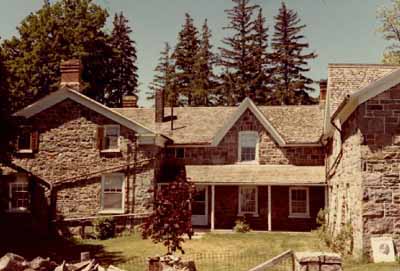Thistle Ha' Farm National Historic Site of Canada
Pickering, Ontario

General View
© Parcs Canada | Parks Canada
Address :
Concession 7 near Brock Road, Claremont, Pickering, Ontario
Recognition Statute:
Historic Sites and Monuments Act (R.S.C., 1985, c. H-4)
Designation Date:
1973-06-11
Dates:
-
1840 to 1870
(Construction)
-
1853 to 1973
(Significant)
Other Name(s):
-
Thistle Ha' Farm
(Designation Name)
Research Report Number:
1973-D June, 2004-SDC/CDE-016
Plaque(s)
Existing plaque: Concession 7 at Brock Road, Claremont, Ontario
This farm was acquired about 1848 by John Miller, a Scottish immigrant who became a pioneer importer and breeder of pedigreed livestock in Canada. In 1852 the Millers began importing quality stock, notably shorthorn cattle, Clydesdale horses and later Shropshire sheep from the United Kingdom. Miller's example, as well as the animals bred at Thistle Ha', played an important role in improving stockbreeding throughout North and South America in the 19th century. Succeeding generations of Millers have maintained the farm's reputation for raising fine blooded stock.
Description of Historic Place
Thistle Ha’ Farm National Historic Site of Canada is a working farm comprised of 80 hectares of farmland with a farmstead including a stone house, a large wooden barn and various outbuildings. It is located within the municipality of Pickering, north of Lake Ontario and slightly northeast of Toronto. The designation refers to the farm with its buildings and landscape of some 80 hectares of agricultural land.
Heritage Value
Thistle Ha’ Farm was designated a national historic site of Canada because of its historic associations with John Miller; a pioneer, importer and breeder of pedigree livestock in Canada. Miller’s example played an important role in improving stock breeding throughout North and South America in the 19th century.
The heritage value of this site resides in its identity as a farm originating in the 19th century, illustrated by its agricultural fields, and major buildings, including the stone house and large wooden barn. Thistle Ha’ Farm was established when Scottish immigrant John Miller acquired it in 1848. In 1852, he began importing quality livestock, notably Durham cattle, Shropshire sheep and Clydesdale horses from the United Kingdom. His family have continued the farm as a breeding and farming operation since that time.
Source: Historic Sites and Monuments Board of Canada, Minutes, June 1973, June 2004.
Character-Defining Elements
Key elements contributing to the heritage value of the site include: the farm as a complete cultural landscape including the farmstead and agricultural lands in their original function; the siting of the farmstead (house and major barn) in relation to the concession road it faces and the farmlands extending behind it; the house with its one-and-a-half-storey tripartite massing under gable roofs, local fieldstone construction laid in squared coursed rubble on the façade and random on side elevations, the classically inspired vernacular design and additive construction with earliest section a storey-and-a-half rectangular, side-gabled massing with a three- bay facade, central entry door with side lights and transom, and multi-pane windows, surviving evidence of original centre-hall plan, surviving interior detailing including stair rail and newel post, panelled window reveals, decorative plaster work, and faux painting finishes; the barn with its rectangular massing under a gambrel roof, local fieldstone foundation, wood-frame construction with board sheathing, metal roofing, functional plan for livestock shelter including door and window openings on ground level and surviving evidence of silo; the presence of a variety of other vernacularly designed and built outbuildings.